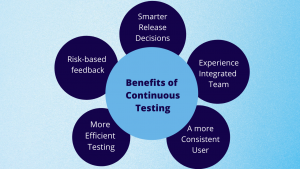

Understanding the benefits of Continuous Testing
Continuous testing is important to improve quality, accelerate releases and reduce costs incurred in developing software. Automated tests are used to ensure that development teams receive immediate feedback to quickly identify and rectify all the risks throughout the software development lifecycle. Thus, continuous testing has become a must for the organizations and developing teams to ensure that software that is coming into the market can let them survive in the competitive world.
Benefits of continuous testing are:
- Risk-based feedback
Continuous testing services ensure that software features are ready for prime time before release. Actionable feedback helps developers and management in finding and fixing critical bugs.
Automated risk-based insights help cover more business risks than manual testing. When managers have all the data, they need to evaluate a release, and developers can make better design decisions at the moment.
- Smarter release decisions
Agile, DevOps, and continuous delivery have accelerated software design, development, and delivery. Releases can occur every two weeks to 1,000 times per day.
Automated testing keeps up with accelerated release processes and remains competitive.
Without a thorough understanding, poorly vetted release candidates can cause greater harm.
Feedback can help developers decide when and how to release the latest changes. Many companies use automated tools to help them balance the increasing complexity of code with the increased demand for faster application delivery.
- More efficient testing
Continuous testing enables developers and managers to run the right tests at the right time, determining whether a delivery pipeline shift is necessary.
Automated end-to-end testing reduces the number of false positives and timeouts common in traditional test environments. By performing tests at each stage of software development, developers can rest assured that they are creating a safe and flexible framework.
It eliminates needless repetition and saves time. As users demand new features, continuous testing ensures software companies have the strongest architecture.


- A more consistent user experience
Continuous testing is critical in preventing faulty code from reaching users and disrupting their experience. Software developers must balance providing users with the latest features and not disrupting their experiences.
Since the software is now the primary means of connecting businesses with their customers, a poor user experience is a failure for a business.
In-depth testing ensures taking into account all aspects of the user’s experience. Once a vendor’s software is ready for prime time, this helps to maintain its brand and reputation.
- Integrated teams
Continuous testing benefits every team member in the development pipeline, promoting efficient collaboration and no longer a need to hand over production-ready code to siloes QA testers.
Teams are more integrated and aware of the pipeline because they assess quality throughout the software development cycle. Today’s software companies rely on continuous testing to ensure high-quality code from the start.
Conclusion
Continuous testing enables faster releases by detecting issues early in the development life cycle, which ultimately reduces the time and cost of the overall project.
Continuous testing is beneficial in many ways, but the organization needs to have a good strategy to implement it, so that all the departments – testers, developers and operations can work in collaboration to remove all the bottlenecks.






